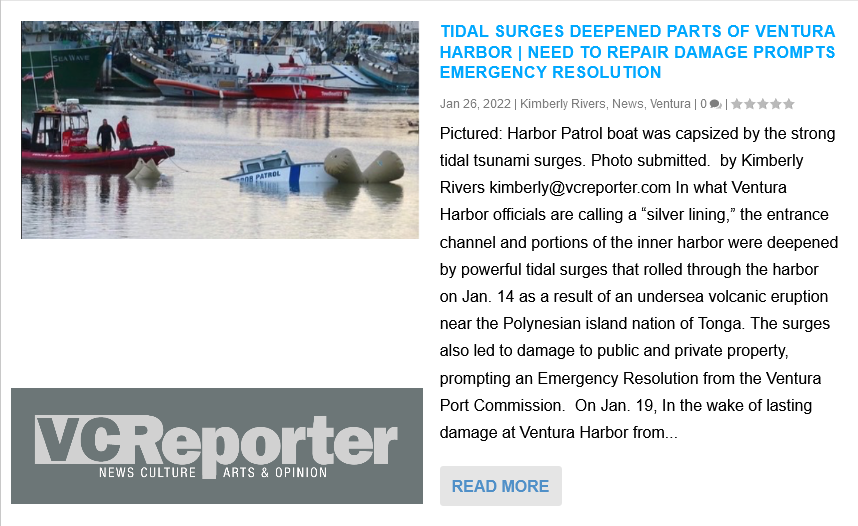Recent Tsunami caused by Volcano has resulted in an examination of the Alert system from the state level down.
There was a lot of confusion regarding lack of information and concern on January 14th, 2022, when tidal surges rolled through local harbors.
The “alert” messages posted pretty much said we were not anticipating any real noticeable impact.
There was a lot of back and forth on social media while watching docks rise and fall in Mandalay Bay as information began to trickle in about real damage in Ventura Harbor.
Our City Councilman, Bert Perello sent us an update today regarding the work going on behind the scenes to learn from that event and make changes for the future!
Subject: Fwd: Tsunami Debriefing and After Action
Honorable Mayor, Council Members & City Staff,
Alex Hamilton, MBA
From: Brewer, Scott <scott.brewer@oxnard.org>
Date: Wed, Jan 26, 2022 at 4:04 PM
Subject: Tsunami Debriefing and After Action
To: Alexander Hamilton <alexander.hamilton@oxnard.org>
Cc: John Colamarino <john.colamarino@oxnard.org>, Karsten Guthrie <karsten.guthrie@oxnard.org>
Chief Hamilton
This email is a follow-up to our response to the January 9th Tsunami “Alert” response. While I believe our response to this incident was both timely and appropriate, I did have some concerns specifically connected to the communications and notification process between Oxnard and The County of Ventura.
On Tuesday, January 25th a debriefing was held at the Ventura County EOC to review this response and specifically the notification procedures surrounding the event. Here are some of the findings, immediate actions, and planning issues resulting from that meeting:
FINDINGS:
- This event was highly unusual and did not fit traditional earthquake and tsunami models:This tsunami was the result of an undersea volcano and not a typical seismic event. The Tsunami Warning System is designed to detect and alert when earthquakes are recorded over a specific magnitude. When an earthquake occurs in a specific area and exceeds the sensor’s magnitude threshold, an automatic notification is sent out. The experts monitoring the system then do a rapid analysis to determine the likelihood, severity, and potential location(s) of any ensuing tsunami. This analysis also determines what level of threat (warning, alert, watch, or threat) will be affixed to that event. Different threat levels may be assigned to different geographic areas depending on a large number of factors. This information is then sent out through the Tsunami Warning System. In the case of the January 25th event, the earthquakes associated with the eruption did not reach a sufficient magnitude to trigger the automatic warning system. In addition, once detected, traditional undersea earthquake-tsunami models, did not appear to apply to the event. Once additional analysis of the data was performed, proper notifications were made.
- California appeared to be at minimal risk and received a “Tsunami Alert” rather than a “Warning”: When the California State Warning Center received the “Alert” it was considered a “non-event” for our portion of the State. As such at approximately 4:40 am an email was sent out from the State Warning Center to the coastal counties notifying them of the “Alert”. Without a higher level of notification, many counties and cities were unaware of the “Alert” notification sitting in their email inboxes.
- Ventura County Notifications:When the Ventura County OES Duty Officer received the “Alert” notification combined with the statement of a “non-event” for our area, and with the knowledge that local fire and police agencies had also been copied on the Warning Center email, they made the determination that no public or local government notifications were required.
IMMEDIATE CHANGES TO PROCEDURES:
- Notifications to local agencies at the “ALERT” level: Beginning immediately, Ventura County OES will change their procedures and notify local cities, agencies, and special districts, via phone or text, of all “Tsunami Alerts”. This will allow local governments to make their own decisions about what type of protective actions and notifications are needed given the circumstances.
MOVING FORWARD AND FUTURE PLANNING:
- County Tsunami Plan Update: Ventura OES will move up its schedule for updating the County-Wide Tsunami Response Plan. Once an initial draft is complete it will be distributed to the local governments to review, edit, and made additions as required.
- Tsunami Sirens:The County will explore funding sources and the feasibility of installing tsunami warning sirens in the highest risk locations. If this occurs, it is a long-term project.
- New Tsunami Signage:The County will work with the coastal cities to determine if better tsunami warning signage would help to raise the awareness of the public and increase public safety.
- New Notification Technology:The County will work with the local cities and agencies to determine if new automated recognition software could be used to increase the speed and accuracy of emergency warnings, alerts, and notifications by recognizing keywords, formats, and statements used in standard alerts and converting them to text messages.
CONCLUSION:
While this event deviated greatly from previous and expected tsunami models, once we learned of the event, I believe our city responded quickly and appropriately to the threat. The immediate change to Ventura County “Alert” level notification will resolve one of our biggest and most immediate concerns regarding awareness and notification of these events, particularly if they occur during off-hours, weekends, and holidays. Updating the County-Wide Tsunami Plan will give us, our partner cities, and local agencies an opportunity to evaluate and improve the plan in light of this recent real-world event.
Overall I think we need to look at this event as an excellent “dress rehearsal”. There are many lessons and issues that would have never been revealed during a planning session or exercise that came to light on the morning of the 19th. This is our opportunity to work with our partner agencies, review and improve our plans, and explore new technologies that could assist us in protecting our community and its residents.
Link to US Tsunami Warning Center Page: https://www.tsunami.gov/
Respectfully Submitted,
Scott Brewer
—
Scott Brewer
City of Oxnard
Emergency Services Manager
Office: (805) 385-7717
Cell: (805) 616-9677


